One of the more critical elements in finding the right motorhome for you and your family, is the consideration of size – in the widest possible sense. It’s the same thing most would look for when buying any vehicle really, but when it comes to motorhomes especially, yeah, size is a pretty big – and multifaceted – consideration.
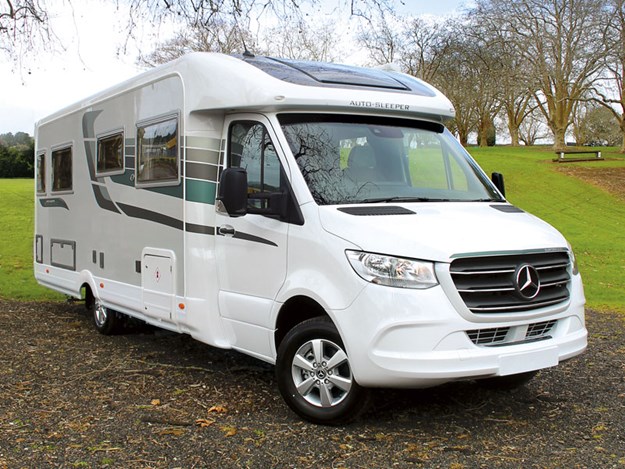
“Is it big enough for the family, but ‘small’ enough to drive?” That’s probably the first brace of questions you might ask, and the Auto-Sleeper Burford Duo seems to have one of those questions answered more than the other. It appears a little larger than some motorhomes, though at a smidge under 8m in length, the impressive on-road presence is a little deceptive.
The Burford Duo feels – and is – extremely driveable by anyone holding a car license. The real test of size is, however, not so much the outside appearance but exactly how much room there is behind that habitation door and how intelligently the space inside has been utilised. Using space intelligently has been the maxim of Auto-Sleepers from the family-run business, which began in the early 1960s.
Back then, the Trevelyan family designed and built their first motorhome on the chassis of a Morris J2 van so they could take “touring holidays with a difference”. Now, a J2 is not a large van and you’d have to be pretty cunning to put a body on it able to cope with a family of four.

The Trevelyans learned a few lessons along the way and refined their second attempt, switching to Austin-based vans, which still required Badger-like nous to put a decentsized body on the back. It worked, though, and the family business soon started attracting attention to itself.
Hiring a local builder to handle the bodywork was the smartest move that could have been made, and Auto-Sleeper has been building bigger and better ever since. And that brings us neatly to the megamotorhome – as I christened the AutoSleeper Burford Duo – (my description’s not such a mouthful), which is a smart- looking body based on the latest-generation Mercedes-Benz Sprinter 316.
I’m going to come back to why the Sprinter is a good choice for the Auto-Sleeper Burford Duo, but before I do, we should probably go inside and take a look at that clever use of space Auto-Sleepers are renowned for.
Living space
 |
Space to stretch |
Arguably the highlight of the Burford Duo, the living space is open-plan apartment style, which some might think precludes being clever with space. After all, you have four walls, a floor and roof – what’s so clever about that? Naturally, you’re going to have space. This is true, but what is clever is that despite the open-plan arrangement, there is still a definite distinction between areas within the space.
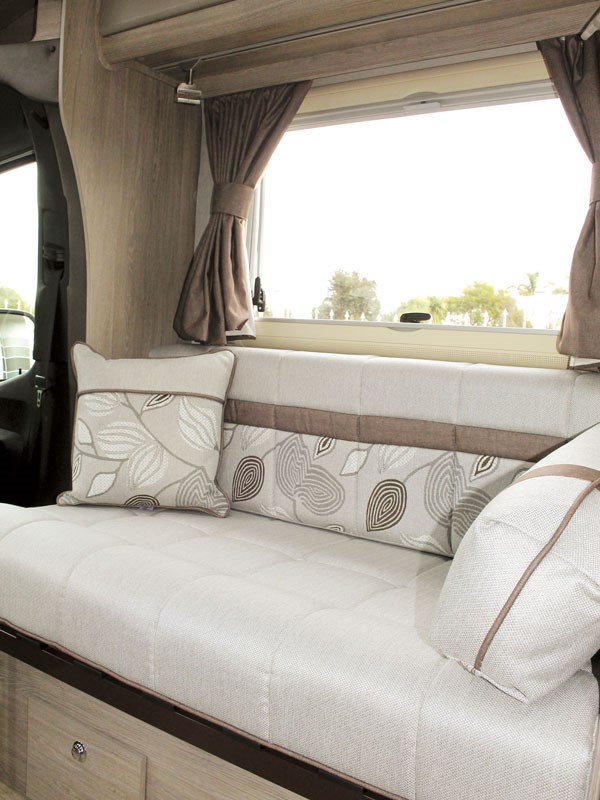 |
Light and comfy |
These are as cleanly defined as if there were walls – now that is a clever trick. The living room or ‘social centre’ to be more accurate, integrates a lounge with seating for six and assumes a dining area, though this last is only a reality when the folding table is drawn out of its slender stowage space alongside the habitation door.
Once the table goes back into stowed mode, the sun goes down and the wheels stop turning, the one-time couches to the left and the right form the basis of a pull-out double bed, thus enabling this Auto-Sleeper to demonstrate its 4-berth accommodations.
With only the slightest hint of a gently curved wood panel at the end of the couches, the lounge seamlessly flows into the kitchen quarter, with hot-food preparation areas on the right and a fridge/freezer and fitted microwave on the left. In between, there’s still room enough to swing a curried cat or stand there flipping flapjacks, whichever is your preference.
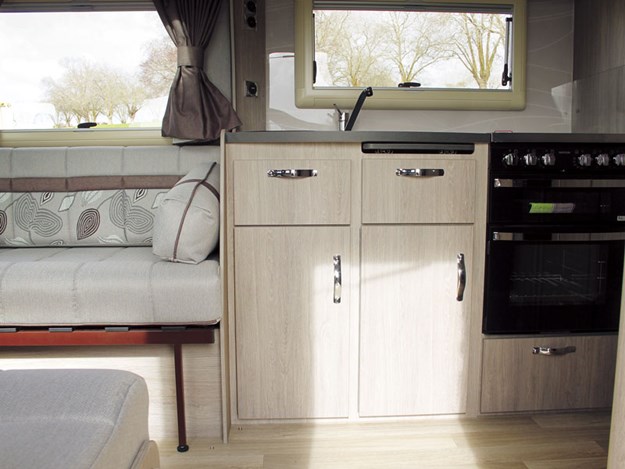 |
Quality kitchen, lots of light |
All of which is a rather clinical examination of what is an artfully designed kitchenette boasting excellent natural lighting and well-integrated overhead cupboard space with quality closure systems. These can also be found in the underbench area, which neatly abuts the hob and oven combination to provide generous counter-top space between it and the sink. Then the fun begins…
Sleeping acommodations
 |
What’s through the door? |
It seems to be a case of ‘down the rabbit hole you go, Alice’ as the open-plan cockpit/living/dining/kitchen space ends somewhat abruptly at a door at the back of the Burford Duo. This is not the end of the road; as the door opens to the fixed sleeping quarters of the Auto-Sleeper, and here’s where buyer choice comes in.
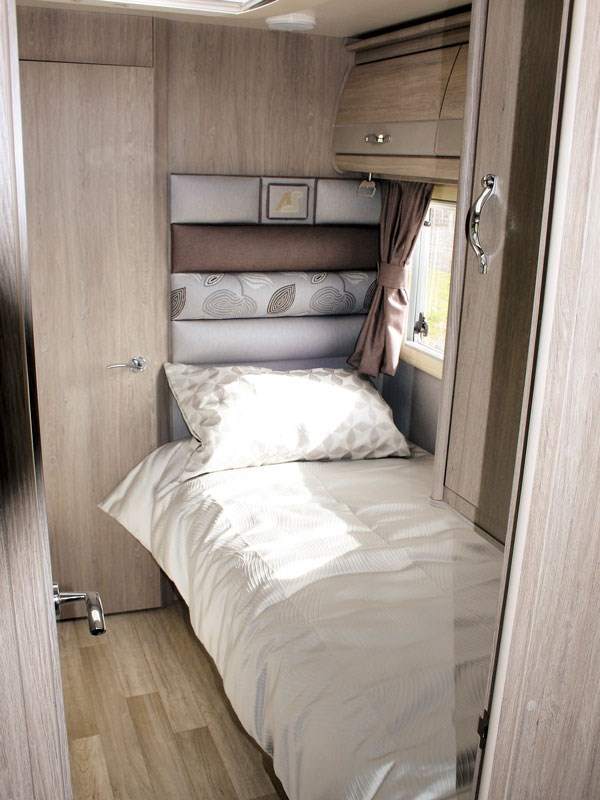 |
The first of the four berths |
You see, the Auto-Sleeper Burford Duo has a doppelgänger in the form of a Burford 4-berth, with the main difference being the bed arrangements/layout. The Burford 4-berth has the pull-out in the lounge but also has a fixed double bed in the closed-off sleeping quarters on the left-hand side.
 |
Plenty of storage |
The reviewed Auto-Sleeper Burford Duo, in the meantime, has two single beds, separated ship-style with a walk-through space between them and plenty of overhead and wardrobe stowage space. There is one other significant difference between the two, and this should be considered in context with who your travelling companions might be.
The Auto-Sleeper Burford Duo has a much larger 125L fresh-water tank, over the Burford’s 91L, so if children/teens are likely to be regular travellers, the AutoSleeper Burford Duo might be a better bet. There’ll be a bed argument over who sleeps right and who sleeps left, but you minimise the risk of the motorhome smelling of un-showered teen spirit.
Bathroom
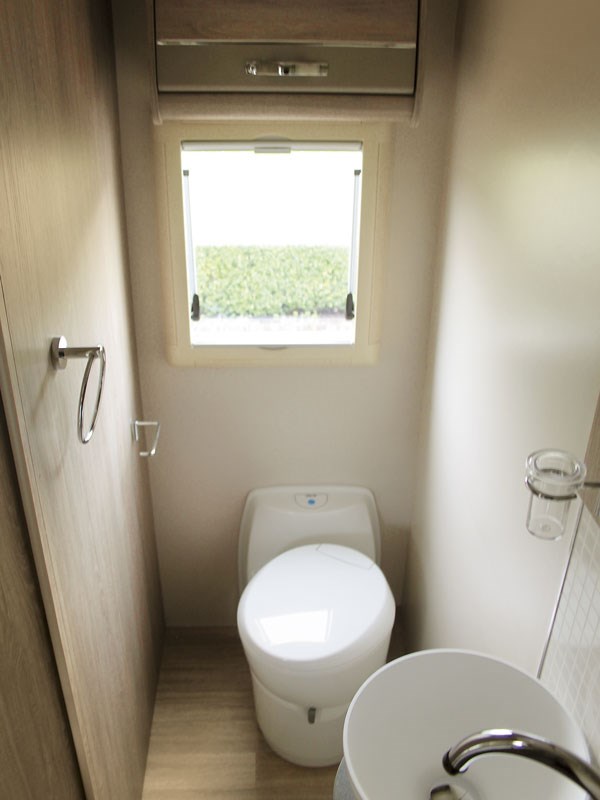 |
Right at the back, where it should be |
And that tidily takes us to the ‘little room’, though the euphemism in this case is ill considered. Once down the hall between the twin beds, there is a second door, this one taking you to the end of the line and the end of the vehicle but into the most necessary of rooms.
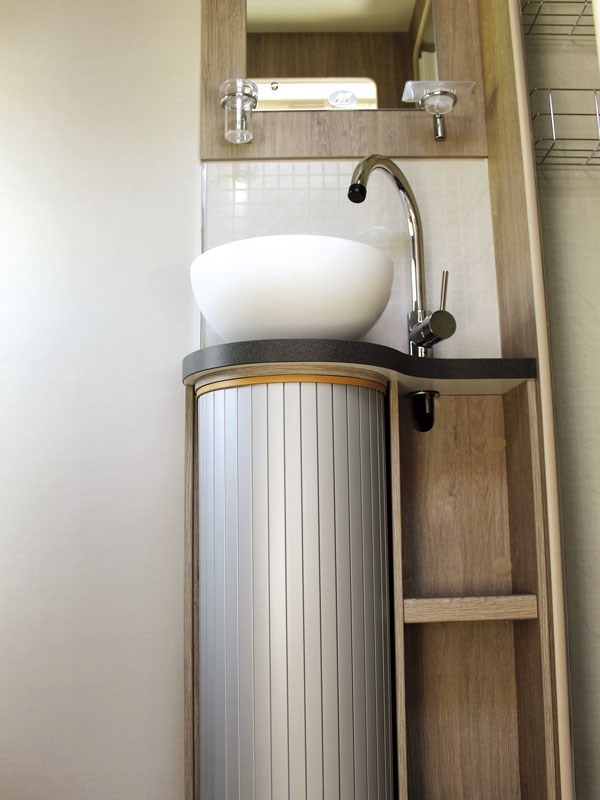 |
A practical, elegant pedestal |
The bathroom is an east/west configuration an elegant washbasin atop a space-saving tower vanity with a modicum of counter-top space and provision for washcloths and towels alongside Given the configuration, it is easy to picture a generous amount of space around the toilet area, while the shower is generous in the extreme in terms of height.
 |
Good for 5’11” height and wide, too |
The shower stall itself is uncluttered save the half-pedestal plumbing and the tasteful tile look puts the shower a step above some found in four-star permanent accommodations. Fittings and fixtures are top-notch and if generous space equates to an indication of quality, well, the bathroom is most definitely quality plus.
Cabin/Cockpit
 |
New-generation Sprinter cab |
The other business end – the cab – of the Auto-Sleeper is 100 per cent Mercedes-Benz traditional. In this, it does have a feeling of a slightly different build to the living area, but in a good way. It inspires confidence in the brand’s ability to build strong, robust vehicles with a lasting pedigree and an assurance of durability.
I mentioned this is the latest generation of Mercedes-Benz Sprinter, which means the dashboard is clean, uncluttered and sophisticated with a 7-inch touchscreen central command screen. This allows access to climate control, navigation, audio selection and such-like, while the multi-function steering wheel brings in sophistication such as Bluetooth telephony and volume controls.
The touchscreen does not, however, pull double-duty as the reversing camera screen. Mercedes-Benz has deemed this an important function and has put a second screen where the rear vision mirror would normally be, a demonstration of the intuitiveness of the cockpit layout.
The seats – those sink-into-and-driveall-day-long-without-effort seats – are well appointed, using a combination of leather bolsters with fabric inlays. They also swivel and are close enough when facing aft to enhance the social feeling of the living space directly behind the cockpit.
Mechanicals
This is an excellent van chassis which features the unusual characteristic of being a rear-wheel drive. Why is this such a big thing? Rear-wheel drive has some definite strengths, especially in the context of a motorhome. With a rear-wheel drive, the vehicle’s mass is spread across all four tyres making for a more stable driving platform.
Also, with the rear tyres doing all the motive work of pushing the vehicle, it leaves the front wheels free to do one thing and one thing only – steer. It is partially this consideration that allows van manufacturers to declare their vehicles “very car-like to drive”, although this isn’t quite true, because most cars are front-wheel drive.
What they mean to say is that while the van is bigger to the driver’s eyes, it is no harder to drive than a smaller car, and this is especially true of the rear-wheel-drive vans like the Sprinter. It helps, too, that the Sprinter is also equipped with some seriously cool kit, including Mercedes-Benz-patented Crosswind Assist.
This works with the electronic stability programme to help drivers maintain control in windy conditions. And, with a body this size, travelling on the Desert Road, say, the feature alone is going to be one you will be thankful for.
Overall
I may have been remiss in omitting comments on some of the finer points of the Auto-Sleeper Burford Duo interior, but in my defence, I was so impressed with the space, size and drive experience, that I went into autopilot. If shared duties behind the wheel is part of your modus operandi for touring, the Auto-Sleeper Burford Duo is one of the most well considered investments you can make for happy holidays.
Find out more at traillite.co.nz.
Auto-Sleeper Burford Duo specifications
| Engine | Mercedes-Benz 2.2 Euro6 |
| Power/torque | 120kW/360Nm |
| Gearbox | 7-speed automatic |
| Berths | 4 |
| Length | 7880mm |
| Width | 2780mm |
| Height | 2880mm |
| Fresh water | 1 x 125L |
| Grey water | 1 x 91L |
| Gas | 2 x 11kg |
| GVM | 3880kg |
| Payload | 497kg |





